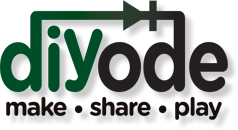Christoph Kesting of DIYode spoke about art creating vision and vision helping us and those around us. He will be creating a comfortable, beautiful home out of an ordinary shipping container at the rear of the DIYode parking lot. Follow him on his container-house-ontario blog. He will be facilitating workshops to show anyone how to do it themselves.
Bob DeGregory is from Kwartzlab, another makerspace in Kitchener. He described how before modern technology, people were using low tech means to move large, very heavy objects. He spoke about a few techniques to move rocks weighing tonnes, all by hand.
Bernie Rodhe is from Kwartzlab as well. He has created an artpiece made from an arduino (a microprocessor) and LEDs in the shape of a lady’s face. The soundwaves from the area around this piece are instantaneously displayed by the LEDs, making an active and ever changing light dance.
Mel Wilson spoke about how a small chip, the WIZnet 5100, can help your small Arduino microprocessor communicate on the internet. This WIZnet chip has four built in internet sockets and an ethernet interface. As with everything Arduino, the coding is open source, and allows another big step in Arduino functionality.
Matt Harding of DIYode has an idea for a guitar that outwardly looks like it has a regular wooden body, but betrays a sophisticated electronic interior making cutting edge sound. He hopes to produce it and offer it for sale in a novel way.
T. Shawn Johnson of DIYode spoke about the Mystic Maze Project, which is a community built maze that can be installed anywhere an event takes place. Portable sections of the maze can be sponsored and decorated by patrons. His goal is to create a maze large enough in which one can get truly lost.
He also gave a talk about various free digital 3D programs and their attributes so that we can create our own three dimensional models ready for printing, laser cutting, or milling.
Glenn McKnight’s talk was about Solar Electric Systems for Remote Off-Grid Applications. The size of a small suitcase, this kit is able to be deployed for use as power for lighting and medical equipment in remote locations without realiable sources of electric power. He is collecting teams to help assemble these kits to be deployed worldwide.
Seth Hardy is one of the cofounders of Site 3, a makerspace in Toronto. He has developed a safe “flame effect” device. We certainly noticed the large balloons of spectacular fire outside!
Ben Grossman of Guelph is a multitalented musician. He and his son prepared a collection of salvaged and hacked electronic components and old toys to show us what strange and interesting noises they can make.
Carl Penny of Site 3, a makerspace in Toronto, is a multitalented artist. Carl mentioned many projects he has completed, including chain mail and scale mail that were expertly knitted into fascinating wearable art. He laser cuts leather as well as sheet latex, then transforms them into unique items of clothing. He makes clothing components from 3D printed plastics and metals. Site 3 participated in Burning Man 2012, for which he programmed motion capture gloves which controlled jets of fire to respond to movement in a real life action game.
Dan O’Connell, a robot enthusiast from Kwartzlab in Kitchener, created a very lifelike boy that rides on a trike….except it’s not a boy. People think something is a bit off when they see it only to discover that it’s a robot. Dan explained all the pieces and how they all fit together.
We assembled our name badges with the contents of a small bag of various electronic components. DIYode’s own Simon Clark has put together a kit to teach soldering, some rudiments of electronics, and some basic programming sketches. He calls the finished project the “CodeShield”.
Tony Thompson from DIYode spoke about where the art of soldering electronic components has been and where it’s going. He discussed various types of breadboards, as well as the soldering process, and which soldering wires and fluxes to use. Something to consider for now and the future is that the size of components is shrinking to the equivalent of a grain of ground pepper. Tony, can you help us?
Zak Homuth, one of the cofounders of Upverter, reviewed the history of this company, which is a “design and collaboration platform”. The open source software they developed lets a user draw the plans of circuits that will lead to hardware components. It’s easy to create a circuit on the fly and past projects submitted by other users are availabe to review as a guide to basic circuit design. Upverter can help bring an electronic idea through the steps to physical product.

Leave a Reply